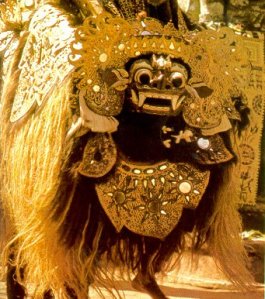 The natural world to the Balinese is one held in balance by two opposing force: the benign, beneficial to man, and the malign, inimical to humanity. The destructive power of sickness and death is associated with the letter force and the evil influence of black magic. If black magic prevails, a village falls into danger, and extensive purification ceremonies become necessary to restore a proper equilibrium for the health of the community. Dramatic art is also a means of cleansing the village by strengthening it’s resistance to harmful force through offerings, prayers and acts of exorcism. Such is the symbolic play of the two remarkable presences-the Barong and Rangda.
The natural world to the Balinese is one held in balance by two opposing force: the benign, beneficial to man, and the malign, inimical to humanity. The destructive power of sickness and death is associated with the letter force and the evil influence of black magic. If black magic prevails, a village falls into danger, and extensive purification ceremonies become necessary to restore a proper equilibrium for the health of the community. Dramatic art is also a means of cleansing the village by strengthening it’s resistance to harmful force through offerings, prayers and acts of exorcism. Such is the symbolic play of the two remarkable presences-the Barong and Rangda.
Barong, a mystical creature wit h a long swayback and curved tail, represent the affirmative, the protector of mankind, the glory of the high sun, and the favorable spirits associated with the right and white magic. The widow witch Rangda is its complement. She rules the evil spirits and witches who haunt the graveyards late at night. Her habitat is darkness and her specialties lie with the practice of black magic, the destructive force of the left. Both figures are of the same earthly substance, possessing strong magical prowess. Somewhere in a mythical past, the Barong was won over to the side of humanity, and in the play, fights on behalf of the people against the intruding death force of Rangda.
 Often the struggle occurs within the framework of popular story; for instance; an episode from episode from Mahabratha. Yet the essence of the Barong and Rangda play remains the eternal conflict of two protagonists. Because the play is charged with sorcery and magic charms, extensive offerings are made beforehand to protect the players during the performance.
Often the struggle occurs within the framework of popular story; for instance; an episode from episode from Mahabratha. Yet the essence of the Barong and Rangda play remains the eternal conflict of two protagonists. Because the play is charged with sorcery and magic charms, extensive offerings are made beforehand to protect the players during the performance.
Usually the Barong enters first, cleverly danced by two men who form the forelegs and hind legs, the first man manipulating the mask. A Barong’s appearance varies with the kind of mask it wears, which may be stylized version of a wild boar, a tiger, a lion, or occasionally an elephant, the most holy mask and the one used in the play is that of the Barong Ketket, “ The Sovereign Lord of the Forest”, a beast representing no known animal. In the extreme coordination of lively Barong, one forgets the fantastic creature isn’t acting on its own accord, as it mischievously sidesteps and whirls around, snapping its jaws at the gamelan, and swishing flies its tail.
After the Barong’s dance, everyone falls silent. From behind the temple gate appear the splintery fingernails that foreshadow the dreadful vision of Rangda. From her mouth hangs a flaming tongue signifying her consuming fire, and her neck, a necklace of human entrails falls over her pendulous breasts. Howling a low, gurgling curse she stalks the Barong while waving a white cloth from whence issue her overwhelming magic.
They collide in a desperate clash of witch craft. In the protection of the Barong lies the preservation of the community, represented by the “kris dacer”, men armed with kris daggers. At one point in the fight, when the victory of the Barong’s assistance by violently attacking Rangda. The witch’s spell reverses their fury back into themselves, and they begin to plunge the blades of their krisses inward against their own bodies. But the Barong, with its own powerful charm, protects the crazed men from inflicting self-harm.
In most plays, this phenomenal self-stab-bing is enacted when the kris dancers are in trance. No matter how forcefully they plunge the daggers against their chest, the tips of the blades do not puncture the skin. At the end of the play, the kris dancers are revived by the pemangku, who sprinkles them with holy water which has been dipped in the berad of the barong. (The beard, made of human hair, is considered the most sacred part of the Barong.). A final offering is made to the evil spirits by spilling the blood of a live chicken.